#dan dailey actor
Text
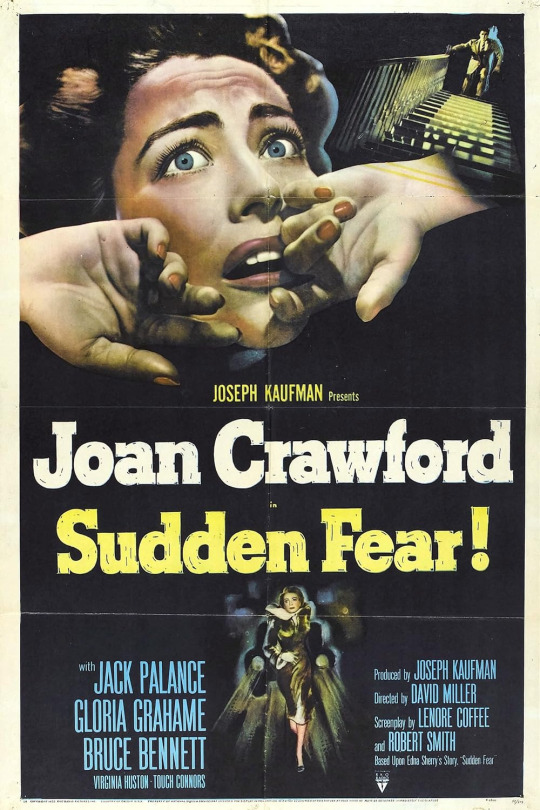


Haterating and hollerating in the 1950s:
SUDDEN FEAR (1952): Inventive but unsatisfying thriller about a middle-aged playwright and heiress (Joan Crawford) who discovers that her new husband (Jack Palance) and his ex-girlfriend (Gloria Grahame) are plotting to do away with her, and decides to concoct her own elaborate trap for the would-be killers, which doesn't go as planned. Palance is well-cast, walking an interesting line between charm and sociopathy, and the film gives Crawford one of her better '50s roles, but the script fails to pay off its own clever plot twists while allowing Crawford too many opportunities for her customary histrionics — particularly in a pair of over-the-top dream/fantasy sequences and in a crucial scene where the heroine has to express, without dialogue, that she's having second thoughts about her own plan. The finale, while undeniably tense and featuring striking nighttime cinematography by Charles B. Lang Jr., also feels like it belongs in a completely different movie.
THE GIRL NEXT DOOR (1953): Bright, attractively staged Fox musical (with two animated interludes) about the burgeoning romance between a successful stage star (June Haver) and her handsome new next-door neighbor (Dan Dailey), a comic strip artist and widower with a young son (Billy Gray) who's none too happy at this new competition for his father's attention. Haver and Dailey are great, and their easy repartee is very appealing. It's also interesting to see Dennis Day outside of his more familiar role as Jack Benny's idiot stooge. However, Billy Gray's character never quite rings true; there's no real reason for Joey to dislike the charming, good-humored Jeannie other than childish jealousy, so the story depends on his eventually getting over it rather than on Jeannie winning him over, which might have been more fun.
A SUMMER PLACE (1959): Overwrought Delmer Daves adaptation of a Sloan Wilson novel about two one-time lovers (Richard Egan and Dorothy McGuire), now unhappily married to others (Constance Ford and Arthur Kennedy), who decide to divorce their respective spouses so they can finally get married, only to face endless angst because their college-age kids (Sandra Dee and Troy Donahue) are also in love, in A Society That Just Doesn't Understand™. The story might have been considered daringly blunt by the standards of 1958–59, but to modern eyes, it succeeds mostly in putting the "turgid" in "dramaturgy." The script and direction are so unrelentingly heavy-handed that the actors seem like they're mining coal, with only Constance Ford (whose character is an unmitigated bitch) allowed to be anything other than laboriously tormented.
#movies#hateration holleration#sudden fear#joan crawford#jack palance#the girl next door#dan dailey#june haver#dennis day#a summer place#sloan wilson#delmar daves#sandra dee#troy donahue#richard egan#dorothy mcguire#constance ford#sloan wilson is best known as the author of the man in the gray flannel suit#a novel from which the tv show mad men borrows quite shamelessly#(it was made into a popular but so-so movie with gregory peck)
7 notes
·
View notes
Text
MOVIES on TV!
Part 3 ~ The Movies of “Here’s Lucy”

In “Here’s Lucy,” Lucille Ball had a new character, a new family, and a new show - but one thing remained constant, her love of movies! Here are some of the movies (real and imagined) of “Here’s Lucy.”
~FACTUAL FILMS~

“Lucy and Carol Burnett” aka “The Unemployment Follies” (1971)
Carol and Lucy stage a tribute to Hollywood using unemployed actors. The films mentioned and/or feted include:
TO HAVE AND HAVE NOT (1944)
BLUE ANGEL (1930)
CASABLANCA (1942)
42ND STREET (1933)
THE WIZARD OF OZ (1939)
SINGIN’ IN THE RAIN (1952)
ROSE MARIE (1954)

The set is decorated with posters from:
HOLLYWOOD OR BUST (1956)
SAMPSON AND DELILAH (1949)
THE GREATEST SHOW ON EARTH (1952)
SHORT CUT TO HELL (1957)
GONE WITH THE WIND (1939)
UNDER TWO FLAGS (1936)

“Ginger Rogers Comes To Tea” (1971)
Ginger Rogers leaves her purse in a movie theatre where she's gone incognito to see one of her films for the first time. Lucy and Harry discover the purse and hope to get to meet the star in person by inviting her to tea. Instead of working late, Lucy tells Harry that she wants to go to a Ginger Rogers Film Festival. They are showing Tender Comrade (1943) and Flying Down To Rio (1933), two films made at RKO, which eventually became Desilu.

Rogers tells Lucy she has done 73 movies. Rattling off some of Rogers' hits, Lucy adds a sugar cube to Ginger's tea for each title: Top Hat, Roberta, Flying Down To Rio, Follow the Fleet, Shall We Dance, and The Barkleys of Broadway. When Lucy realizes she's put six lumps of sugar in Ginger's tea, Rogers says she only wanted Top Hat and Roberta (two lumps).

Trying to impugn the taste in films of the mystery woman (a disguised Ginger Rogers), Lucy tells her to try back next week and they might be showing Beach Blanket Bingo (1965). This was the fourth of the light comic films set on the California beach starring Frankie Avalon and Annette Funicello.

After dancing the Charleston with Lucy and Kim, Lucy asks Rogers to do a scene from Kitty Foyle, Ginger’s Oscar-winning role. Rogers graciously declines, asking Lucy to become a Katherine Hepburn fan instead!

“Guess Who Owes Lucy $23.50?” (1968)
Lucy loans Van Johnson money to fix his car – but the man turns out to be an impostor. This episode is written for Van Johnson to work in a not-so-subtle plug for their latest film Yours, Mine and Ours (1968) starring Henry Fonda.
VAN IMPOSTER:“I loved working with that kooky redhead.”
LUCY: “Personally, I thought she was much too young for Henry Fonda.”
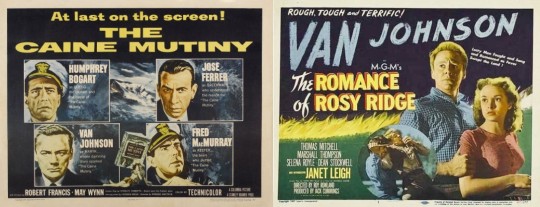
Lucy says she remembers Johnson from his appearance in The Romance of Rosy Ridge (1947). She later tells him she saw the film 17 times! When Lucy is escorted out by the studio guards at Van’s direction, Lucy says that now she’s glad he got court martialed in The Caine Mutiny (1954).

“Lucy and Aladdin’s Lamp” (1971)
When Lucy holds a garage sale, she discovers an old lamp that she believes may be make wishes come true. Lucy pulls out a fur-lined jacket she says was worn by Joan Crawford in Mildred Pierce. The 1945 film won Crawford an Academy Award. Craig says that judging by the shoulder pads she could have worn it in The Spirit of Notre Dame, a 1931 football-themed movie starring Lew Ayres.

“Lucy and Flip Go Legit” (1971)
Lucy takes a temp assignment with Flip Wilson in order to answer his fan mail. When she is caught sneaking into Wilson’s office to ask him a favor, she gets caught and fired. The favor is to appear in a community theatre production of Gone With The Wind (1939) – as Prissy. Lucy plays Scarlett O’Hara, Harry plays Rhett Butler, and Kim takes the role of Melanie Wilkes.

“Won’t You Calm Down Dan Dailey?” (1971)
Lucy gets a job working for Dan Dailey. When he starts to dictate a letter to Paul Newman at Universal Studios, Lucy says she saw Newman on the late show in Winning, a 1969 film about a race car driver.

“Lucy and Rudy Vallée” (1970)
Famous crooner Rudy Vallée is waiting tables to pass the time until his music comes back into style. Lucy convinces Kim to help update his look and sound while Harry gets him a booking at the local teen hangout. When a life-size portrait of Vallée in a raccoon coat is revealed, Vallée says he wore the coat in his first picture, Varsity Hero, a silent picture where critics raved about his singing!

In reality, Vallée’s first film (aside from two shorts playing himself) was The Vagabond Lover in 1929.

“Lucy and Chuck Connors Have a Surprise Slumber Party” (1974)
Harry rents out Lucy’s home for a movie shoot. After causing several re-takes, Lucy is banished from her own home. When she returns early, she doesn’t know that Chuck Connors is staying overnight – in her bed!
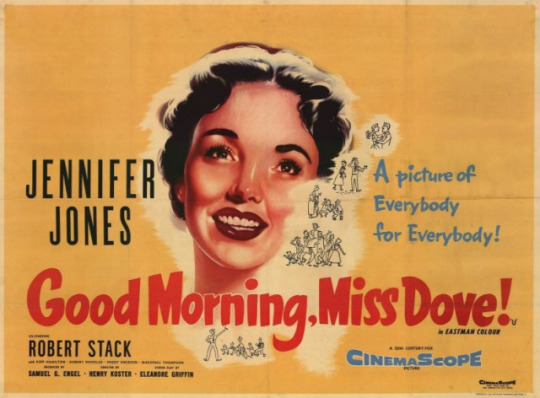
Jerry, the film’s director, tells Chuck that his film Good Morning, Miss Dove starring Jennifer Jones is on television that night. Connors says the film was one of the few times he got to nuzzle something besides a horse. Released in 1955 by 20th Century Fox, the film co-stars Mary Wickes, a frequent guest star on all of Lucille Ball’s sitcoms. It also features Jerry Paris, who directed two episodes of “Here’s Lucy” before being fired, and Robert Stack of Desilu’s “The Untouchables.” Other “Lucy” alumni in the film include Herb Vigran, Hal Taggart, and Arthur Tovey – all appearing uncredited.

“Lucy Meets the Burtons” (1972)
The hotel manager tells Burton that the back door is mobbed by the Elizabeth Taylor Fan Club – Glendale Chapter. Membership to the club requires seeing National Velvet 10 times! National Velvet (1945) was made when Taylor was just twelve years old.
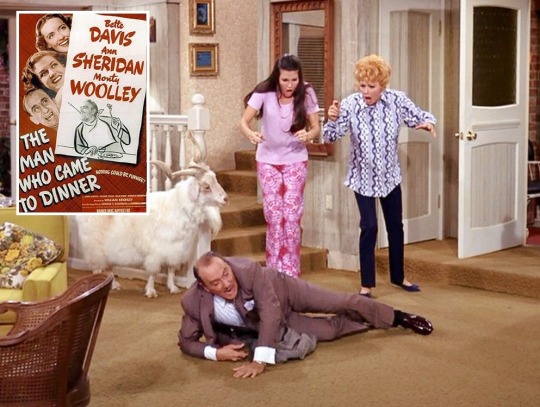
“Lucy’s House Guest, Harry” (1971)
As Harry is finally is finally about to leave, Lucy has a horrible thought: what if he is like Sheridan Whiteside in The Man Who Came to Dinner and falls on his way out and must stay with them even longer? The play, by George S. Kaufman and Moss Hart, opened on Broadway in 1939. It starred Lucille Ball's good friend (and “Here's Lucy” performer) Mary Wickes as Nurse Preen. Wickes was one of several actors who recreated their roles in the 1942 film adaptation.
~FICTIONAL FILMS~

“Lucy, the American Mother” (1970)
Craig makes a film about Lucy, a typical American mother. During the episode, Kim does impressions of Katharine Hepburn in Stage Door (1937), a film that also featured Lucille Ball, Maurice Chevalier in Innocents of Paris (1929), and Bette Davis in The Great Lie (1941).
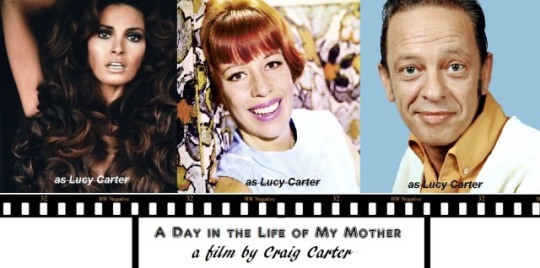
The title of Craig's movie will be “A Day in the Life of My Mother.” When Lucy can't seem to act natural in front of Craig's camera, she suggests he get someone else to play his mother; someone like Raquel Welch, Carol Burnett, or Don Knotts.
~FILM INSPIRATIONS~
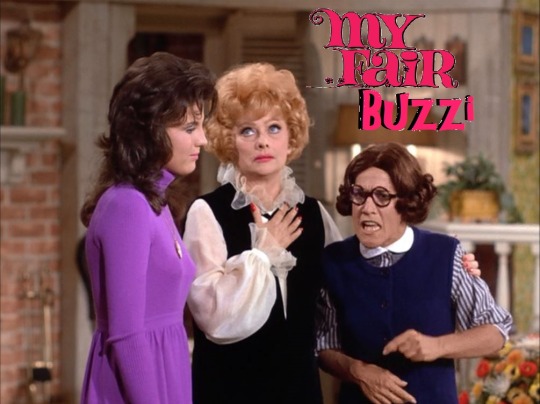
“My Fair Buzzi” (1972)
Kim’s shy and awkward friend Annie (Ruth Buzzi) comes out of her shell in order to audition for a 1920s revue, only to find the director was looking for someone shy and awkward in the first place! The episode title and story of transformation were inspired by the 1956 Broadway musical and 1964 film My Fair Lady, which, in turn, was inspired by George Bernard Shaw’s Pygmalion. Both are mentioned in the dialogue of the episode.

“Dirty Gertie” (1972)
Lucy gets a surprise fruit basket and heads downtown to share her good fortune with her hairdresser. On the street she is mistaken for Dirty Gertie, an apple peddler who just happens to be the good luck charm of a local gangster. This episode was inspired by the 1961 Frank Capra film Pocketful of Miracles in which Bette Davis played Apple Annie, a poor woman reduced to selling apples on the street. The film featured previous “Lucy” co-stars Edward Everett Horton, Jay Novello, Ann-Margret (film debut), Sheldon Leonard, Jerome Cowan, Fritz Feld, Ellen Corby, Benny Rubin, Hayden Rorke, Bess Flowers, Vito Scotti, Bert Stevens, Arthur Tovey, and Romo Vincent.

“Lucy Runs the Rapids” (1969)
The Carters take a road trip in a camper. The episode opens with the soundtrack playing “Breezin’ Along”, the theme song from The Long, Long Trailer (1954), a film starring Lucy and Desi as a couple honeymooning in a trailer.
~FILM FAKES~

“Lucy Cuts Vincent’s Price” (1970)
Price is filming a new horror film titled Who’s Afraid of Virginia’s Wolfman? He says it has the best title since he starred in The Giant Chihuahua That Ate Chicago.
~FILM REFERENCES~
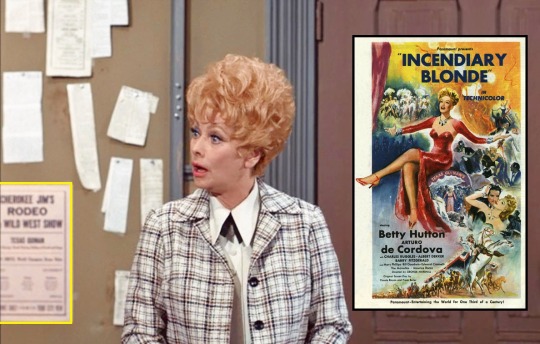
“Lucy, the Cement Worker” (1969)
In Pierre’s the knife thrower’s studio, there is a handbill on the bulletin board for ‘Cherokee Jim’s Rodeo and Wild West Show’, which is a direct reference to the 1945 film Incendiary Blonde starring Betty Hutton as Texas Guinan. The film was directed by George Marshall for Paramount, the same director and studio producing this episode of “Here’s Lucy” 25 years later!

“Lucy in the Jungle” (1971)
When Harry sees baby chimps Fido and Rover, he reminds Lucy and Kim that King Kong started out as a baby, too! King Kong, Hollywood’s tale of a giant ape, was first filmed in 1933, then re-made in 1976 and 2005. Fay Wray, one of the stars of the original film, also made The Bowery that same year, one of Lucille Ball’s first films.

“Lucy and the Ex-Con” (1969)
Lucy and Rocky (Wally Cox) go undercover as little old ladies to catch a crook. When Lucy and Rocky pass out (as planned) one of the crooks says to the bartender “Give me a hand with arsenic and old face.” Arsenic and Old Lace is a 1944 film where two elderly spinsters serve lethal glasses of elderberry wine to unsuspecting older gentlemen and bury them in their basement!

“Lucy and The Generation Gap” (1969)
Lucy and Uncle Harry help Kim and Craig stage the school musical. In the first act of the musical set in ancient Rome, Lucille Ball is reading a magazine called 'Roman Scandals’. Roman Scandals is also the title of Lucille Ball’s uncredited film debut in 1933.
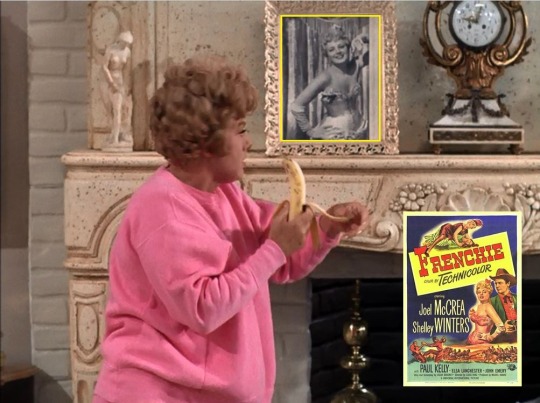
“Lucy and Shelley Winters” (1968)
Hired to watch over dieting movie star Shelley Summers. On the mantle of Summers' apartment is a photo of a svelte Shelley Winters from the 1950 film Frenchie. She glances guiltily at the photo when she is about to overeat.
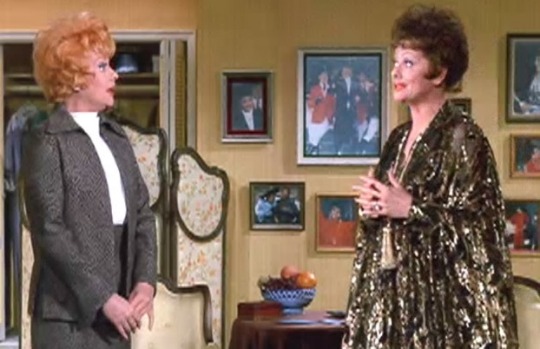
“Lucy Carter Meets Lucille Ball” (1974)
Although Lucille Ball's dressing room wall is lined with photographs of Mame and the soundtrack plays the title tune by Jerry Herman, the name of the movie is never specifically mentioned. The film was given its world premiere on March 7, 1974 three days after this episode first aired, and released nationally three weeks later. As Mame, Lucy failed to ‘charm the husk off of the corn.’
#Lucille Ball#Here's Lucy#Gale Gordon#TV#Movies#Shelley Winters#Vincent Price#Wally Cox#Bette Davis#Ruth Buzzi#Ginger Rogers#Van Johnson#Lucie Arnaz#Desi Arnaz Jr.#Carol Burnett#Don Knotts#Racquel Welch#Richard Burton#Elizabeth Taylor#Chuck Connors#Dan Dailey#Flip Wilson#Rudy Vallee
10 notes
·
View notes
Text
Your Daly Devotional: Of James, Tyne and Timothy Daly
It takes being a biographical blogger to know how common some surnames are in certain fields, and there are a LOT of actors named Daly, Daily or Daley: Augustin Daly, Arnold Daly, Dan Daly (and his siblings), Dan Dailey (different spelling), Peter F. Dailey, and Bill Daily. If any of these folks are related its probably way back in the timeline and in the old country (Ireland). Today we look at…

View On WordPress
#actor#Broadway#Cagney and Lacey#Diner#films#James Daly#Medican Center#Television#Tim Daly#Timothy Daly#tv#Tyne Daly#Wings
5 notes
·
View notes
Photo

Tim Holt, Humphrey Bogart, and Walter Huston in The Treasure of the Sierra Madre (John Huston, 1948)
Cast: Humphrey Bogart, Walter Huston, Tim Holt, Bruce Bennett, Barton MacLane, Alfonso Bedoya, Arturo Soto Rangel, Manuel Dondé, Jose Torvé, Margarito Luna. Screenplay: John Huston, based on a novel by B. Traven. Cinematography: Ted D. McCord. Art direction: John Hughes. Film editing: Owen Marks. Music: Max Steiner.
It's always shocking to realize that Humphrey Bogart failed to be nominated for an Oscar for his performance as the bitter, paranoid Fred C. Dobbs, the anti-hero of The Treasure of the Sierra Madre. I mean, who today remembers some of the performances that were nominated instead: Lew Ayres in Johnny Belinda (Jean Negulesco)? Dan Dailey in When My Baby Smiles at Me (Walter Lang)? Clifton Webb in Sitting Pretty (Lang)? To the Academy's credit, John Huston won as both director and screenwriter, and his father, Walter, won the supporting actor Oscar -- the first instance of someone directing his own father to an Academy Award for acting -- which his smartly delineated old coot certainly deserved. The Treasure of the Sierra Madre has a generosity of characterization in both the screenplay by John Huston from B. Traven's novel and the performances of Bogart, Walter Huston, and Tim Holt. Let's also put in a word for Holt, who had one of the odder careers of a potential Hollywood star: He gave good performances in some of the best movies to come out of the studios in the 1940s, including The Magnificent Ambersons (Orson Welles, 1942) and My Darling Clementine (John Ford, 1946), and was a handsome and capable presence in them. But even after working for Welles, Ford, and Huston, after The Treasure of the Sierra Madre he went back to performing in B-movie Westerns, which had been the stock in trade of his father, Jack Holt (who has a small part as a flophouse bum in this film). Tim Holt's heart seemed not to be in the movie business, and he retired to his ranch, making only a few appearances after 1952. The Treasure of the Sierra Madre was mostly filmed on location -- a rarity for the time -- in the state of Durango and the town of Tampico, Mexico. (Some scenes had to be shot in the studio, of course, and it's easy to spot the artificial lighting and hear the sound stage echoes in these, which don't match up to the ones Ted McCord filmed on location.)
4 notes
·
View notes
Photo




French dignitaries and stars of stage, screen and TV will join at the Rivoli Theatre here tomorrow evening in a special ceremony marking the opening of "Les Miserables," and the reopening of the theatre.
Participating in the salute to the 150th anniversary of Victor Hugo's birth will be Jean F. Charvet, acting French Consul General in New York, and French United Nations representatives with guests from other international delegations.
Montague Salmon, managing director of the Rivoli Theatre here, will be breaking bread with representatives of the French government and other distinguished guests at the opening of "Les Miserables" on Broadway today, and such a loaf of bread ! It took 10 of Hanscom's bakers 14 hours to ferment and mix the gigantic loaf of French bread, which measures eight feet long, weighs 30 pounds and required three hours baking time.
Experts estimate it would require an average American four months to consume the loaf, but an average Frenchman, such as Jean Valjean, who was condemned to the galleys for the theft of a loaf of bread, might eat this enormous loaf in a single month.
Also in attendance at the premier were actors Dan Dailey, Constance Smith, Jayne Meadows, “Gregory,” and Kyle Macdonnell. Assuming this is the same premier event, the photos above show Gene Raymond and Jeanette MacDonald (left), Richard Barthelmess and Jessica Stewart Sargent (middle), and Joan Bennett and Gene Markey (right).
Sources: the Motion Picture Daily, 13 August 1952 / The Film Bulletin, 11 August 1952 / the Modern Screen, July 1952
5 notes
·
View notes
Text
Podcast Actor Dan Dailey Golden Age of Radio Tribute
0 notes
Text
Birthdays 12.14
Beer Birthdays
John Frederick Wiessner (1831)
Simon Fishel (1846)
Vic Kralj (1959)
Five Favorite Birthdays
Tycho Brahe; Danish astronomer (1546)
Shirley Jackson; writer (1919)
Ginger Lynn; porn actor (1962
Stan Smith; tennis player (1946)
Clark Terry; jazz trumpet player (1920)
Famous Birthdays
Morey Amsterdam; comedian, actor (1908)
Jane Birkin; English singer, actor (1946)
Dan Dailey; singer, dancer, actor (1913)
Ernie Davis; Syracuse RB (1939)
James Doolittle; aviator (1896)
Patty Duke; actor (1946)
Cynthia Gibb; actor (1963)
Scott Hatteberg; Oakland A's 1B/C (1969)
Vanessa Anne Hudgens; actor (1988)
Spike Jones; bandleader, comedian (1911)
Abbe Lane; singer, actor (1932)
Krissy Lynn; porn actor (1984)
Natasha McElhone; English actor (1971)
Nostradamus; French astrologer, physician (1503)
Michael Ovtiz; talent agent (1946)
Lee Remick; actor (1935)
Charlie Rich; country singer (1932)
Jon Staggers; Green Bay Packers WR (1948)
Charles Wolfe; Irish poet (1791)
Tata Young; Thai singer, model, actor (1980)
0 notes
Text

Day 54- Film: What Price Glory?
Release date: August 22nd, 1952.
Studio: 20th Century Fox
Genre: War
Director: John Ford
Producer: Sol C. Siegel
Actors: James Cagney, Corinne Calvet, Dan Dailey
Plot Summary: During the later part of WWI, American Troops in France are getting younger and less experienced. Captain Flagg requests help training the green young men, but when that help arrives, it is his old nemesis, Sergeant Quirt. The rivalry between them heats up even more when they both fall for the same French girl.
My Rating (out of five stars): ** ½
This may not have been the worst film on my list so far, but it was without question the hardest to sit though. It wasn’t fortuitous for this film to line up as the one to watch directly after The Quiet Man- both are John Ford comedy dramas with an excessive running time and lots of macho men bonding while drinking and fighting. I find all of that a bore, honestly. I didn’t really care about the characters, and the film seemed torn over whether or not to question war or glorify it.
The Good:
I liked the fact that there was a lot of French spoken in the film, and it wasn’t subtitled or cut down too much.
There was some sentiment that popped up occasionally about the futility of war or the cost of sending very young men to fight, but it often got undercut by other parts of the film. This was not a film that glamorized war, however, which I appreciated.
The Bad:
It’s ridiculous for a stunningly beautiful young French girl to be torn between a funny looking short pudgy guy of about 50, and a 40-ish guy who isn’t much more attractive. Looks and age are not everything, I know, but this just felt unbelievable.
All the macho bullshit that I’ve discussed already today and yesterday.
Like The Quiet Man, this was too long.
Like The Quiet Man, the characters were not developed well at all.
The French girl Charmaine could literally have been a mannequin. I can’t think of one single personality trait or interest she had, except for her love of soldiers. I guess she sang a couple of songs, so I’d infer she likes music?
The other French girl character- she is supposed to be a schoolgirl of 17 who starts seeing a 22-year-old American soldier. They gave the actress pigtails and put minimal make up on her, and I swear she looked about 14 years old. It was creepy.
Normally I like James Cagney a lot, but I didn’t like him in this. He just kind of swung from being blandly gruff to gratingly gruff. At times it gave the impression that he was just phoning it in.
I didn’t really understand or get invested in the rivalry between Cagney and Dailey, even after they fell for the same woman.
Dailey is also an actor that can be very appealing, but I found him hard to like here.
This was supposed to be a comedy/drama, but I did not find much funny in it at all.
0 notes
Text
Cantinflas in Hollywood By Raquel Stecher

Comic film star Mario Moreno, AKA Cantinflas, was affectionately referred to as the “Mexican Charlie Chaplin”. With his baggy pants tied up with a rope instead of a belt, his signature cap and distinctive mustache, Cantinflas became famous for his on-screen persona as a pelado, a Mexican slang term for an urban bum. The name Cantinflas, which he gave himself as a way to hide his show business career from his disapproving parents, became a term in its own right. Cantinflismo or to cantinflear was to talk like Cantinflas; in other words, to deliver rapid-fire dialogue in a way that would make a simple conversation more complicated, ultimately leading nowhere to great comedic effect. Cantinflas got his start as a teenager performing song-and-dance numbers in a traveling carpa, or tent show. He also performed as a circus clown, acrobat and a bullfighter which would later serve him well in his acting career.
Cantinflas was a huge star in Mexico and in the Spanish-speaking world in general. His appeal, besides his talents for verbal and physical humor, was the common theme of his Everyman character outwitting authorities. In an interview with the actor he once said, “Cantinflas no tiene edad… yo no me quito los años. Lo que pasas es que no me lo pongo./Cantinflas has no age… I didn’t take the years off. What happened is that I never added them on.” The ageless Cantinflas character served Mario Moreno well in a career that spanned over four decades.
Producer Michael Todd was looking for an international star for what would be the biggest project of his career: AROUND THE WORLD IN 80 DAYS (‘56). Todd took notice of Cantinflas and cast him in the film in the part of Passepartout, the fearless and clever assistant to Phileas Fogg, played by David Niven. Cantinflas received second billing for his first Hollywood movie but his role was expanded and he was given additional scenes not featured in Jules Verne’s novel, including a bullfighting sequence, to showcase Cantinflas’ talents and give him more screen time. AROUND THE WORLD IN 80 DAYS was a lavish production complete with an all-star cast. It went on to win the Academy Award for Best Picture the following year. Cantinflas excelled in the role of Passepartout and won a Golden Globe for Best Actor in a Comedy or Musical. It was a huge box office success and Cantinflas received top billing for the film in international markets to better capitalize on his worldwide fame.
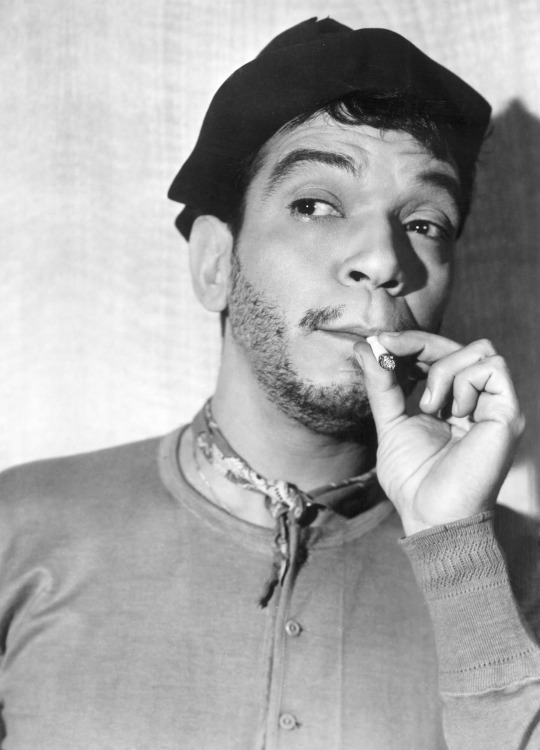
Todd and Cantinflas became close. Cantinflas even helped coordinate Todd’s wedding to actress Elizabeth Taylor in Mexico, served as a witness for the ceremony and arranged a firework display for the reception. Todd would have overseen Cantinflas’ next Hollywood project had it not been for his untimely demise in a plane crash in 1958. AROUND THE WORLD IN 80 DAYS was so successful that director George Sidney was able to convince Columbia Pictures to invest $5 million in Cantinflas’ next movie PEPE (‘60). This time, the film would boast even more all-star cameos and have Cantinflas as the top-billed star.
Based on an Austrian play Broadway Zauber, PEPE stars Cantinflas as a horse handler who loses his beloved horse, whom he affectionately refers to as his son, to washed up actor turned director Ted Holt (Dan Dailey). Shirley Jones plays Suzie, the love interest to both Pepe and Ted Holt. Sidney took cameos to the next level by involving big names such as Greer Garson, Edward G. Robinson, Frank Sinatra, Jack Lemmon, Janet Leigh, Bing Crosby, Kim Novak, etc. in scenes that would help move the plot forward. PEPE was shot over six months with five weeks of on location shooting in Mexico. For all intents and purposes, PEPE was meant to be a big vehicle for the international star. Bolstered by a big budget and a bevvy of stars, the intention was to not only capitalize on the successful formula of AROUND THE WORLD IN 80 DAYS but to make Cantinflas famous in the US.
Unfortunately, PEPE did Cantinflas no favors. The film was filled with tired Mexican stereotypes. The character Pepe is presented as a simpleton who means well and serves to help the troubled Tim Holt and aspiring actress Suzie achieve their dreams. According to Cantinflas biographer Jeffrey M. Pilcher, “Moreno lacked the confidence to try fast-talking in English, and throughout the filming he retained his Mexican director, Miguel Delgado, who spoke the language fluently, to coach him through the uninspired dialogue.” Perhaps 1960s Hollywood wasn’t quite ready for Cantinflas to play Cantinflas and tried to manufacture a character with Pepe that would be safe for the American moviegoing public. Unfortunately, the critics panned the film and it didn’t drive audiences to the theater quite like AROUND THE WORLD IN 80 DAYS did. The film was released on Christmas Day in 1960 and earned $4.8 million at the box office which was not enough to break even. It did go on to be nominated for seven Academy Awards, although it lost all seven, and Cantinflas was once again nominated for a Golden Globe for his performance.
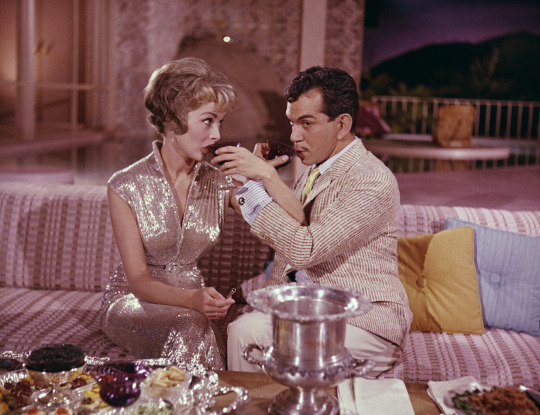
AROUND THE WORLD IN 80 DAYS was a much better platform for Cantinflas to showcase his talents whereas PEPE was a sad finale to Cantinflas’ short lived Hollywood career. Cantinflas never made another American film although he was to play a part in the obscure film THE GREAT SEX WAR (‘69) that was never released. Cantinflas returned to his native Mexico where he made films throughout the 1960s and 1970s. Despite only making two films in the United States, he was recognized for his achievements with a star on the Hollywood Walk of Fame in 1980.
#Cantinflas#Mexican Hollywood#Classic Hollywood#Pepe#Around the World in 80 Days#TCM#Turner Classic Movies#Raquel Stecher
123 notes
·
View notes
Text
❤❤❤❤

Marilyn Monroe on the set of There's No Business Like Show Business, 1954

The film crew (actors and actresses) pose on their custom chairs: Ethel Merman, Dan Dailey, Marilyn Monroe, Donald O'Connor, Mitzi Gaynor and Johnnie Ray.
*Source: divinemarilyn.com
#marilyn monroe#marilyn monroe in 1954#marilyn monroe on the set#marilyn monroe behind the scenes#theres no business like show business#1954 celebrity history#1954 celebrity photos#1950scolorphotos#1950sfashion#1950s#1950s actresses#decade: 1950s#1950s celebrity photos#vintagephotos#vintagewomen#vintagefashion#vintage hollywood#vintage cinema#vintage films#vintage celebrity photos#old hollywood stars#old movies#old hollywood#old films#Hollywood glamour#1950s Hollywood#classicfilms#classichollywood
3 notes
·
View notes
Text
On December 14 ~ in Music History
On December 14 ~ in Music History

Christmas Countdown: O Little Town Of Bethlehem
• 1911 ~ “Spike” (Lindley Armstrong) Jones, American drummer, bandleader of satiric music
• 1913 ~ Dan Dailey, Singer, dancer, actor
• 1914 ~ Rosalyn Tureck, American pianist and harpsichordist
• 1920 ~ Clark Terry,…
View On WordPress
#bandleader#Christmas Music#composer#Duke Ellington#guitarist#harpsichordist#pianist#Richard Wagner#Sergei Sergeyevich Prokofiev#Today in Music History#video
1 note
·
View note
Text
BETTY GRABLE
December 18, 1916
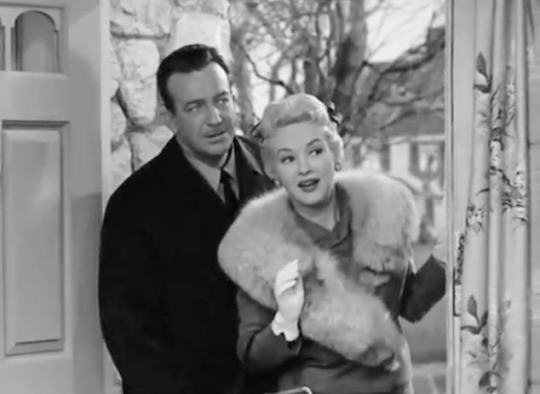
Elizabeth Ruth Grable was born in St. Louis, Missouri, the youngest of three children. Nicknamed ‘Betty’ as a child, she was pressured by her mother to become a performer. She was entered in multiple beauty contests, many of which she won or for which she achieved considerable attention.

A 12-year-old Grable and her mother traveled to Hollywood in 1929, hoping to achieve stardom. To get her daughter jobs, Lillian Grable lied about her daughter's age, claiming she was 15. That same year, she made her uncredited film debut as a chorus girl in the all-star revue Happy Days (1929).
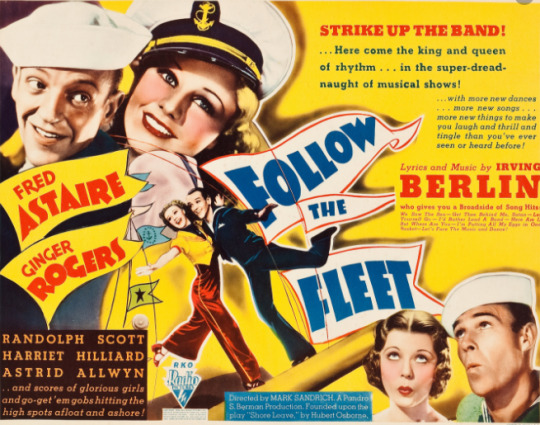
In 1930, at age 13, Grable (under the pseudonym Frances Dean) became one of the original Goldwyn Girls, along with Ann Sothern, Lucille Ball and Paulette Goddard. Grable appeared with Lucille Ball in the short A Night at the Biltmore Bowl (1935), Old Man Rhythm (1935), and Follow the Fleet (1936).
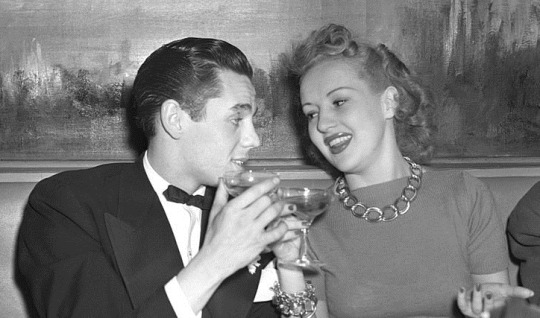
In late 1939, Betty Grable dated Desi Arnaz when the two were concurrently appearing on Broadway; him in Too Many Girls and her in Du Barry Was a Lady. Coincidentally, Lucille Ball did the 1943 film of Du Barry, taking the lead from Ethel Merman. Grable’s role was re-written and she was not part of the film.

Throughout her career, Grable was a celebrated sex symbol. Her bathing suit poster made her the number-one pin-up girl of World War II. Grable's legs were insured by her studio for $1 million as a publicity stunt.
"I became a star for two reasons, and I'm standing on them." ~ Betty Grable

On an October 1948 episode of Lucille Ball’s radio series “My Favorite Husband” Liz Cugat (Lucy) wonders aloud: “What’s Betty Grable got that I haven’t got?”
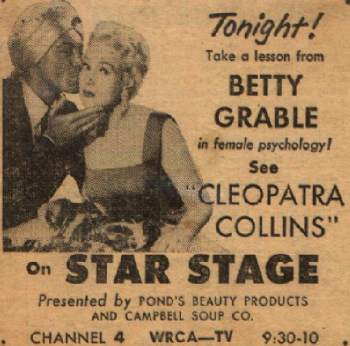
Although she began doing television in 1953 on variety and talk programs, her first scripted program was an episode of “Star Stage” titled “Cleopatra Collins”. Grable played an ex-Miss America. She quickly followed-up by playing Lily Garland in “Twentieth Century” for “Ford Star Jubilee”, an adaptation of the 1932 play about movie stars on a train.

On a November 15, 1954 episode of “I Love Lucy,” Betty Grable’s name is mentioned by Lucy Ricardo as one of the many Hollywood stars she is looking forward to meeting should Ricky get the role of Don Juan.

Once in Hollywood, Lucy gets to see Betty Grable’s Beverly Hills home in “The Tour” (ILL S4;E30) in May 1955. The driver (Benny Rubin) describes the home as a ‘ranch style’.
A few months later, just before returning home from Hollywood, Lucy and Ethel visit the forecourt of Grauman’s Chinese Theatre and see Betty Grable’s leg imprint in a slab of cement.
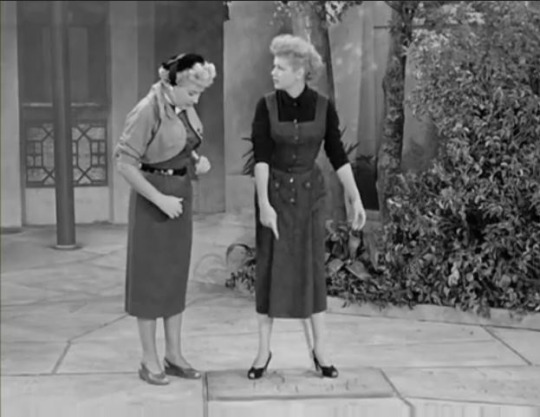
ETHEL: “What are you doing?”
LUCY: “Comparing my leg to Betty Grable’s.”
ETHEL: “Oh, it looks identical.”
LUCY: “Oh, to you and me maybe, but I doubt it would fool Harry James.”
On February 15, 1943, Grable did indeed leave her leg print and signature in wet cement for the forecourt.

Her final scripted role on TV was playing herself in “Lucy Wins A Racehorse”, an installment of “The Lucy-Desi Comedy Hour” on “Westinghouse Desilu Playhouse”. It was filmed in December 1957 and aired on February 3, 1958.

The episode’s theme grew from the James’ and Arnaz’s shared love of horses and horse-racing.

In it, Grable appears with her second husband, bandleader Harry James, who she married in 1943 and with whom she had two children. The couple divorced in 1965. She had first married actor Jackie Coogan, but their relationship lasted only a three years (1937-1940).
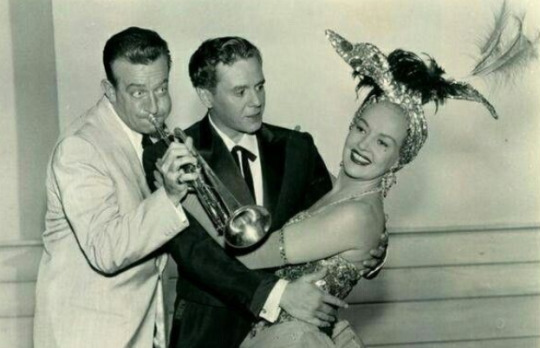
Grable and James do a full out musical performance in the Ricardo living room titled “The Bayamo” in which Grable shows off her legendary legs and James plays his iconic trumpet.
“She was everything to him. It was always Lucy, Lucy, Lucy. She was his life.” ~ Betty Grable, about Desi Arnaz

In the 1969 Dinah Shore TV special “Like Hep!” Betty Grable’s name is dropped in the title song sung by Dinah, Lucy, and Diana Ross. That’s hep!
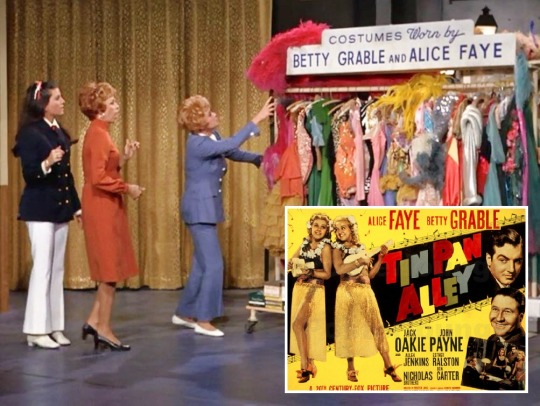
Grable’s name was also mentioned in the February 1971 “Here’s Lucy” episode “Lucy and Carol Burnett aka The Hollywood Unemployment Follies” (TLS S3;E22). During the episode they ogle a wardrobe rack conspicuously labeled COSTUMES WORN BY BETTY GRABLE AND ALICE FAYE. Faye and Grable did two films together, Tin Pan Alley (1940) and Four Jills in a Jeep (1944).

In a November 1971 episode of “Here’s Lucy” Dan Dailey dictates a letter to Betty James and Lucy Carter correctly guesses that he is writing to Betty Grable, who did four films with Dailey.
Betty Grable died at age 56 of lung cancer on July 2, 1973 in Santa Monica, California.

#Betty Grable#Lucille Ball#The Lucy Desi Comedy Hour#Lucy Wins a Racehorse#Harry James#Here's Lucy#I Love Lucy#My Favorite Husband#Follow the Fleet#Desi Arnaz#William Frawley
21 notes
·
View notes
Text
Birthdays 12.14
Beer Birthdays
John Frederick Wiessner (1831)
Simon Fishel (1846)
Vic Kralj (1959)
Five Favorite Birthdays
Tycho Brahe; Danish astronomer (1546)
Shirley Jackson; writer (1919)
Ginger Lynn; porn actor (1962
Stan Smith; tennis player (1946)
Clark Terry; jazz trumpet player (1920)
Famous Birthdays
Morey Amsterdam; comedian, actor (1908)
Jane Birkin; English singer, actor (1946)
Dan Dailey; singer, dancer, actor (1913)
Ernie Davis; Syracuse RB (1939)
James Doolittle; aviator (1896)
Patty Duke; actor (1946)
Cynthia Gibb; actor (1963)
Scott Hatteberg; Oakland A's 1B/C (1969)
Vanessa Anne Hudgens; actor (1988)
Spike Jones; bandleader, comedian (1911)
Abbe Lane; singer, actor (1932)
Krissy Lynn; porn actor (1984)
Natasha McElhone; English actor (1971)
Nostradamus; French astrologer, physician (1503)
Michael Ovtiz; talent agent (1946)
Lee Remick; actor (1935)
Charlie Rich; country singer (1932)
Jon Staggers; Green Bay Packers WR (1948)
Charles Wolfe; Irish poet (1791)
Tata Young; Thai singer, model, actor (1980)
0 notes
Text

Day 27- Film: The Pride of St. Louis
Release date: May 2nd
Studio: 20th Century Fox
Genre: Drama/sports
Director: Harmon Jones
Producer: Jules Schermer
Actors: Dan Dailey, Joanne Dru, Richard Crenna
Plot Summary: This is the life story of famous 1930s baseball pitcher Dizzy Dean. It covers his rise to fame, his marriage, his life-changing injury, and his struggles to find a post-baseball career.
My Rating (out of five stars): ***
I didn’t know anything about Dizzy Dean before I watched this movie, and I didn’t want to read up on him beforehand, fearing it would ruin any surprises. I almost wish I had looked, though, because I spent the whole movie waiting for something really dramatic to happen... and it never did. It ended up being just a simple story of the brief career of a baseball player who everyone remembered as quite a character.
The Good:
The baseball scenes were interesting and well shot. I thought they were some of the most entertaining parts of the film, and I’m someone who doesn’t enjoy baseball much at all.
Dan Dailey was a good combination of being an effective actor and an effective looking sportsman.
The Bad:
There just wasn’t really much drama. Even his career-ending injury wasn’t covered in a way that made the trauma of it real. I think the tone was often too lighthearted- it lowered the stakes for a lot of things.
The movie infantilized him a lot. He acted like a child, and those around him treated him like a child, including his wife. She finally threatened to leave him and refused to come back until he made an adult decision on his own. The film even ends with some neighborhood children coming to the door to ask his wife if he can come out and play with them!
Supposedly the real Dizzy was quite a memorable and colorful character, but the film didn’t show much of anything other than the fact that he was childish and he spoke in a thick uneducated rural southern drawl.
It seemed pretty sanitized. There were very short scenes hinting at the fact that he drank and gambled after his injury, but it was not a realistic portrayal of someone struggling with those issues.
I really did not understand why his wife married him. She was highly educated, he wasn’t educated at all, and he often acted more like her son than her husband.
There was a lot of attention paid in the beginning to his very close relationship with his brother Paul, but then Paul virtually disappeared for the last third of the movie.
0 notes
Text
When Willie Comes Marching Home (John Ford, 1950)
No sé si será por estar protagonizada por un actor (Dan Dailey) que a Ford le caía muy bien (véanse What Price Glory y The Wings of Eagles), pero nunca tuvo categoría estelar, y por ser clara y abiertamente una comedia, género con el que —un tan o absurdamente— no se tiende a asociar a John Ford, pero el caso es que hay pocas obras suyas del periodo posterior a la Segunda Guerra Mundial tan arrinconadas y perennemente subestimadas como When Willie Comes Marching Home.
A primera vista, se puede pensar que es una parodia de la vida militar, un poco en la estela de la magnífica Hail the Conquering Hero (1944), de Preston Sturges, pero cabe sospechar, a poco que se recuerden las circunstancias, que se trata de una historia (aunque escrita con gracia e ingenio por la pareja Mary Loos & Richard Sale y basada en un relato de Sy Gomberg) de resonancias muy personales tanto para el propio Ford como para John Wayne y algunos otros amigos suyos relacionados con el cine, que por lo general fueron considerados más útiles haciendo lo que sabían hacer que en el frente, lo que a unos les resultó frustrante y a otros enojoso o dañino para su imagen y reputación.
Es más, por lo que se ha ido sabiendo de las andanzas como "enlace" o espía (tanto aéreo como naval) de Ford durante la Guerra, se puede pensar que el episodio con la Resistencia francesa (y con Corinne Calvet) y la filmación del lanzamiento de un proyectil V-2 quizá esté cerca de alguna de sus peripecias biográficas.
Como cabe deducir de esta somera alusión al conflicto básico de la película, When Willie Comes Marching Home se inscribe (y muy brillantemente) en una rama muy minoritaria de la comedia, que yo llamaría "comedia-pesadilla", cuyas muestras —poco numerosas— abarcan desde Good Sam (1948), de Leo McCarey, y I Was a Male War Bride (1949), de Howard Hawks, hasta The Long Long Trailer (1953) y Goodbye Charlie (1964), de Vincente Minnelli, y Hail the Conquering Hero y The Miracle of Morgan's Creek (1942/3), de Preston Sturges, pasando por algunas obras sueltas de George Cukor, Blake Edwards, Rouben Mamoulian, Douglas Sirk, Frank Tashlin y Billy Wilder.
No es, ciertamente, el terreno más transitado habitualmente por Ford, pero es una muestra más de la equivocada tendencia a simplificar sus habilidades e intereses reduciéndole a la condición de director de westerns, que hizo muchos, y muy buenos la mayoría, pero que solo representan una parte no mayoritaria de su obra digamos "madura", es decir, una vez superado el periodo de aprendizaje y cuando ya había llegado a la etapa sonora, que es la que, en realidad, justifica su estatura como uno de los más grandes creadores del cine de modo más pleno y regular.
Creo importante no olvidar, cuando a veces se reprocha a un cineasta de dilatada carrera e inmensa filmografía su falta de homogeneidad, que esta característica es un objetivo probablemente facilitado, si no impuesto, por la estructura industrial de la producción cinematográfica, tanto en Hollywood como en el Japón, pero al que los directores ansiosos de independencia, o al menos de variedad, tendían a agarrarse como a un clavo ardiente porque al menos, en contrapartida, constituía una oportunidad, precisamente, de evitar verse encasillados en el campo, a fin de cuentas limitado, de un solo género o incluso de un bloque multigenérico más amplio como el que englobaba la etiqueta de "cine de acción" (que, además del de aventuras y el western comprendía el bélico, el de piratas y contrabandistas, el de caballeros medievales, espadachines, espías y demás, pero aún así con ciertos rasgos comunes y con tendencia a ser "películas de hombres" y dominadas por actores masculinos). Se conocen varios directores, muy hábiles en estos terrenos, que, contra sus deseos, se vieron confinados a ese tipo de películas, cuando a lo mejor habrían preferido seguir los pasos de Frank Borzage, Frank Capra o David Lean. Algunos así lo confesaron, como Don Siegel, y de otros cabe sospecharlo.
Un detalle no ya sorprendente sino realmente asombroso, sobre todo por la escasa estima de que gozaba John Ford en esos años y teniendo en cuenta la muy generalizada reticencia frente al cine "comercial" norteamericano y la sistemática minusvaloración de la comedia, del cine cómico y en general de todo lo divertido y no solemne por la mayoría de los jurados de los festivales de cine: When Willie Comes Marching Home ganó el Grand Prix del Festival de Locarno de 1950.
Miguel Marías
Libro “El universo de John Ford”, editorial Notorious (2017)
Escaneo: @AitorL_
0 notes
Text
December 14 ~ On This Day in Music
December 14 ~ On This Day in Music
Christmas Countdown: O Little Town Of Bethlehem
• 1911 ~ “Spike” (Lindley Armstrong) Jones, American drummer, bandleader of satiric music
• 1913 ~ Dan Dailey, Singer, dancer, actor
• 1914 ~ Rosalyn Tureck, American pianist and harpsichordist
• 1920 ~ Clark Terry, Trumpet, flugelhorn with Lionel Hampton, Count Basie, Duke Ellington, Quincy Jones
• 1928 ~ America’s original Funny Girl, Fanny…

View On WordPress
#bandleader#Christmas Music#composer#Duke Ellington#guitarist#harpsichordist#pianist#Richard Wagner#Sergei Sergeyevich Prokofiev#Today in Music History#video
0 notes